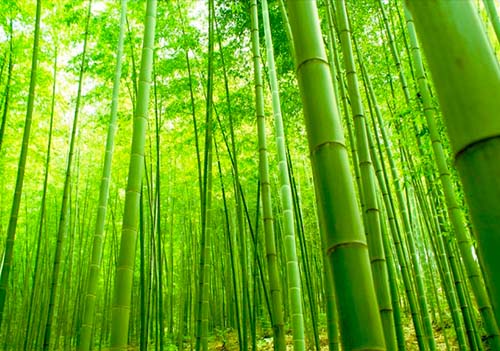In order to measure the sustainability of making Bamboo fabric, we need to better understand fabric making process in general. There are several components that need to be assessed in the value chain such as the primary material used in the textile (cotton, polyester, nylon, bamboo, etc) and whether over consuming this material will place a strain on us humans and our beautiful planet. Furthermore, we need to assess the garment manufacturing, design and prices which determine the product longevity, and finally how that material can be discarded and or re-used or recycled.
Back to Bamboo…..the bamboo plant is part of a subfamily of treelike grasses which comprises more than 1,400 species. It is available naturally and as a cultivated crop, mainly grown in tropical regions regions with largest number of species in South East Asian countries.
Bamboo is a renewable, fast-growing plant, with some species growing as much as 30 cm (1 foot) per day. Bamboo can attain heights ranging from 10 to 15 cm (about 4 to 6 inches) in the smallest species to more than 40 metres (about 130 feet) in the largest. This makes the process of growing the bamboo plant and replacing used crops quite fast and sustainable.
The bamboo plant is also very hardy and resistant to common plant diseases and generally does not require the application of pesticides.
To make Bamboo fabric there are three main methods:
In the mechanical method the plant is harvested, split and cut into chips. The bamboo chips are then soaked in a natural enzyme solution to break them down into a soft material that can be dried into sheets, bamboo fibres can then mechanically combed and brushed into fibres to be made into yarn. This is the preferred method for preserving integrity of the plant fibres and their natural properties.
There are two main chemical methods: one that follows the viscose process used to produce rayon, where the fibre is chemically broken down to form alkali cellulose which undergoes a pressing process and is then treated with other harsh chemicals and extruded through mechanical spinnerets. This is the least desired process as it destroys most of the natural properties that make bamboo so special. The second chemical process follows the closed solvent spinning loop which is essentially the same process used to produce Lyocell fibres. This so called “closed loop system” is much preferred as it employs chemical components which have lower impact on the natural fibre properties. The chemicals are recycled into the process, minimising the volume of chemicals that need to be discarded into the environment. It is also safer to the workers.
Note that the bamboo fibre is biodegradable and will not stay in the environment for decades or centuries as some of the synthetic fibres do, however that also depends on whether it has been blended with other synthetic materials which may affect the biodegradability of the bamboo component.





